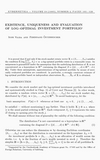Article
Full entry |
 PDF
(0.8 MB)
Feedback
PDF
(0.8 MB)
Feedback
 PDF
(0.8 MB)
Feedback
PDF
(0.8 MB)
Feedback
References:
[1] A. R. Barron L. Gyorfi, E. van der Meulen: Distribution estimation consistent in total variation and in two types of information divergence. IEEE Trans. Inform. Theory 38 (1992), 1437-1454. MR 1178189
[2] L. Breiman: Optimal gambling systems for favouralbe games. In: Fourth Berkeley Symp. Math. Statist. Probab., Vol. I, Univ. Calif. Press, Berkeley 1961, pp. 65-78. MR 0135630
[3] T. M. Cover: An algorithm for maximizing expected log investment return. IEEE Trans. Inform. Theory 30 (1984), 369-373. MR 0754868 | Zbl 0541.90007
[4] T. M. Cover: Universal portfolios. Mathematical Finance 16 (1991), 876-898. MR 1113417 | Zbl 0900.90052
[5] T. M. Cover, J. A. Thomas: Elements of Information Theory. Wiley, New York 1991. MR 1122806 | Zbl 0762.94001
[6] J. Kelly: A new interpretation of information rate. Bell System Tech. J. 35 (1956), 917-926. MR 0090494
[7] H. A. Latane: Criteria for choice among risky ventures. Political Economy 38 (1959), 145-155.
[8] G. Morvai: Empirical log-optimal portfolio selection. Problems Control Inform. Theory 20 (1991), 453-464. MR 1156460 | Zbl 0752.90004
[9] G. Morvai: Portfolio choice based on the empirical distribution. Kybernetika 25(1992), 484-493. MR 1204597 | Zbl 0776.90009
[10] J. Pfanzagl: On the measurability and consistency of minimum contrast estimators. Metrika U (1969), 249-272.
[11] R. T. Rockafellar: Convex Analysis. Princeton Univ. Press, Princeton, N.J. 1970. Zbl 0193.18401
[12] P. A. Samuelson: The 'fallacy' of maximizing the geometric mean in long sequences of investing or gambling. Proc. Nat. Acad. Sci. U.S.A. 68 (1971), 2493-2496. MR 0295739 | Zbl 0226.62111
[13] P. A. Samuelson: Why we should not make mean log of wealth big though years to act are long. Journal of Banking and Finance 3 (1979), 305-307.
[14] S. van deGeer: The method of sieves and minimum contrast estimators. 20th European Meeting of Statisticians, Programme & Abstracts, University of Bath, September 1992, p. 243.

